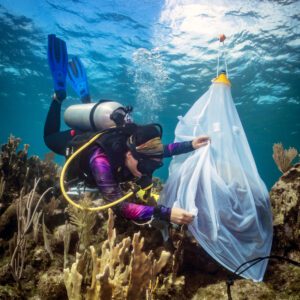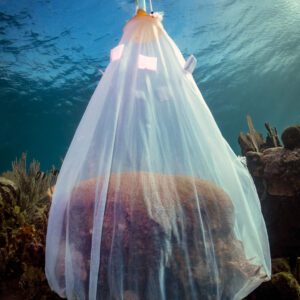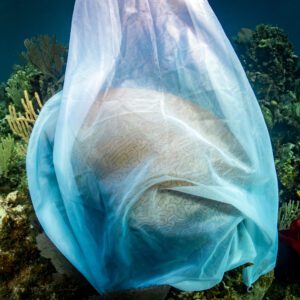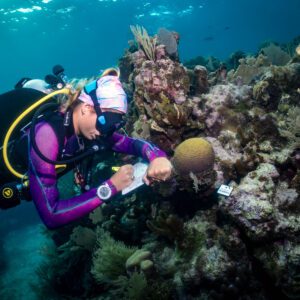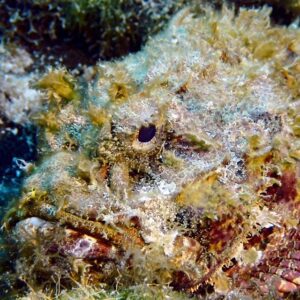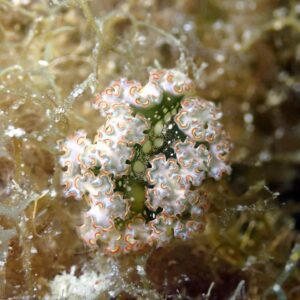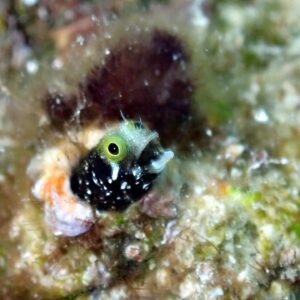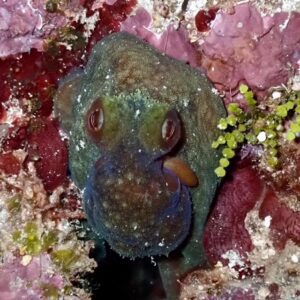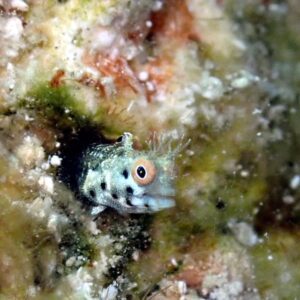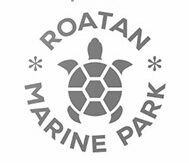Let’s talk about sexual coral restoration, baby!
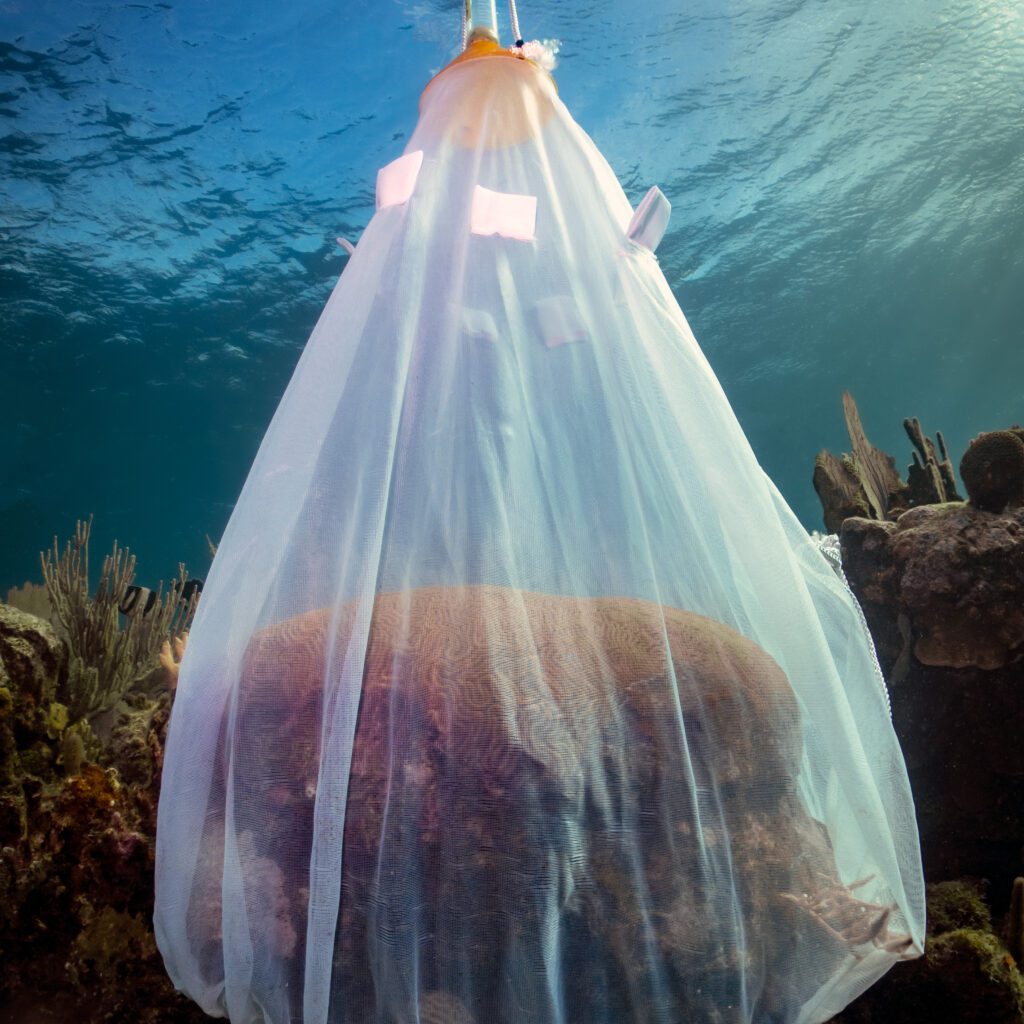
Grooved brain coral covered by gamete collection net. Photo Credit: Gil Sassi
The Roatan Marine Park (RMP) is using some “sexy” new technology to scale up coral restoration efforts. We’re excited to be a part of this cutting edge approach to coral restoration in Roatan.
On July 21 – 26, Sun Divers customers and team members worked with restoration leaders from RMP to monitor coral spawning activity. The six-day volunteer event was conducted to confirm spawning times for Diploria labyrinthiformis, commonly known as grooved brain coral, so that in the future, the gamete (male & female germ cells) could be collected for coral breeding restoration efforts.
So, how do corals breed?!
Corals have a gift of growing and reproducing both sexually and asexually.
Let’s talk about asexual reproduction first. When coral fragments are broken off from their primary colony either through natural causes or with intent for restoration, they can reattach to the reef and start a whole new colony.
Corals also reproduce sexually. This occurs through mass coral spawning events. Hard (or stony) corals release male & female germ cells called gamete all at the same time. The lucky gamete then fertilize. And, much like we learned about in junior high, they become an embryo that turns into coral larvae (also known as planula). Or if you want to keep the sex ed analogies going, you can think of these as little coral ‘babies.’ The planula can then attach to substrate and ultimately grow into a new colony.
What is coral breeding restoration?
For decades, restoration practices, including those in Roatan, have taken advantage of coral’s asexual superpowers, and “propagated” corals by cutting fragments, growing them in a coral nursery, and then outplanting them onto the reef.
While this restoration practice has a solid success rate, it is costly and time consuming. It also requires significant physical space, and manpower.
New technologies are now allowing us to lend corals a helping hand when it comes to the success rate of their sexual reproduction. Specifically in Roatan, SECORE International, a global coral restoration organization, is bringing tools, techniques and talent to help our community increase its efforts in sexual coral restoration.
Most simply, the method used by SECORE International, RMP and local volunteers like ourselves involves these five primary steps:
- Data is collected to confirm coral spawning times for keystone species
- Once a particular species’ spawning time is confirmed, the next time the spawning event happens, the gametes are collected. The corals are covered by a net with a plastic vile that the gamete float up into for collection.
- Gametes are taken to a land-based lab, where they are cross-bred with the hopes of fertilization. Think of this as IVF for corals.
- Coral larvae attach to substrate blocks developed by SECORE and are then kept in Coral Rearing In-Situ Basins (CRIBs) in the ocean.
- Once starter colonies are developed, the blocks are then “seeded” onto the reef. This requires no manual attachment, which can many times be the most time consuming, as well as error-fraught part of the traditional outplanting method.
The in-situ cribs only require 5% of the labor that land based facilities require, and the substrate to seeding method allows major scaling of coral coverage.
How is Sun Divers supporting?
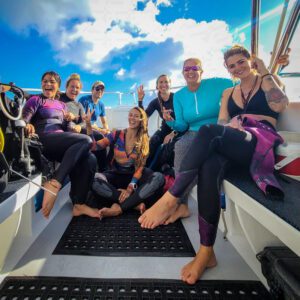
Sun Divers volunteers on their way to monitor. Photo credit: Gil Sassi
As part of our support of the Roatan Marine Park and local coral restoration efforts, Sun Divers contributed boats, tanks, captain time to coral spawning monitoring of grooved brain coral. 18 coral colonies were monitored by over 20 volunteers. These volunteers were trained on how to properly net the corals and collect gamete in the event of a mass spawning event. Unfortunately, one sole coral spawned, but the monitoring provided valuable data to help RMP predict future spawning events.
“Conservation brings science and the community together, so monitoring coral spawning with the diving community is critical for long-term coral restoration efforts and giving our Roatan reef hope. We are grateful to the local dive shops on Roatan, such as Sun Divers, for collaborating with us on these sustainability efforts,” RMP Research Project Coordinator Damaris Dueñas said.
What’s involved in coral spawning monitoring?
A coral spawning monitoring dive is both scientific and entertaining. It’s basically a two-hour (yes, two full hours!) dusk or night dive conducted in a small area where the majority of your focus is on 1-2 coral colonies waiting for that after-dark magic to happen. But while you have one eye on your colonies, you can also focus more intently than on fun dives where you have to keep moving, and watch the reef come to life. If you love macro diving, you’ll love this because you have all the time in the world to let your eyes adjust and discover the interconnected nature of corals, gobies, blennies, crabs, shrimps, pipehorses and more. See the slideshow below for some of our cool findings on one of the dives. Larger life will also pass you by including Eagle Rays, octopus and schools of fish – the butterfly fish seem particularly inquisitive!
Okay, but back to the work at hand. While you’re monitoring, you’ll be capturing important data on an underwater slate including documenting the start & stop time of spawning should it occur.
If spawning occurs, gametes are collected and that’s when the on-land cross-fertilization happens.
How can I get involved?
RMP will continue to conduct coral spawning monitoring with the hopes of kicking off a concerted coral breeding restoration program. If you’d like to get involved you can contact the Roatan Marine Park and Sun Divers to get more details on future opportunities.
We’ll also continue to offer the RMP Coral Restoration Ambassador certification to support the traditional coral nursery maintenance and outplanting. And this is a great way to get involved when coral spawning is not occurring.
What’s next for sexual coral restoration?
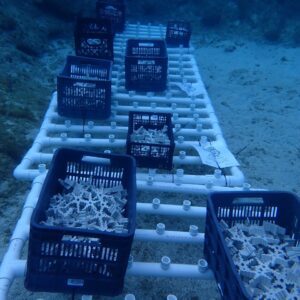
Substrates for sexual coral restoration at Overheat dive site. Photo credit: RMP
Coral spawning monitoring and gamete collection will continue into this year. If you see these substrates pictured right at sites like
Overheat, please do not touch or move them as they are part of the coral restoration efforts.
For the next five years, SECORE International will train, mentor and provide coral breeding restoration tools to the Roatan community so that ultimately we can become self-sufficient in managing coral breeding restoration.


